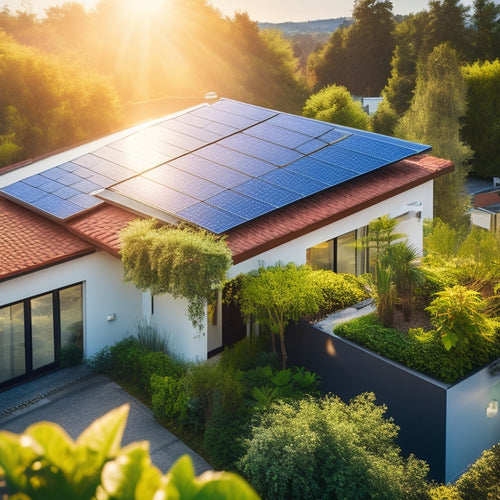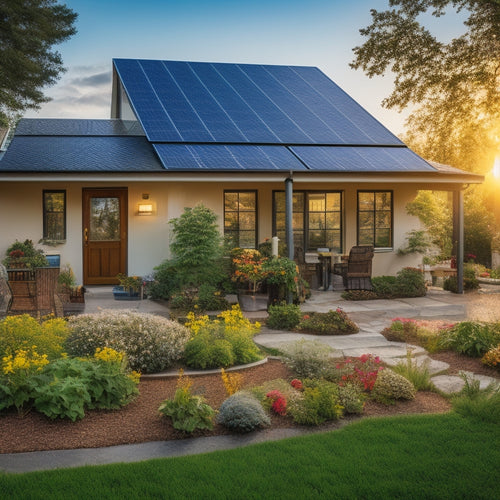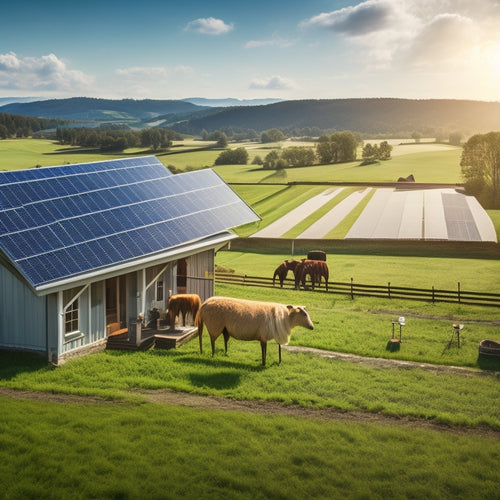
7 Best Ways to Monitor Solar Panel Performance
Share
To monitor your solar panel performance efficiently, install solar monitoring apps for real-time data and use smart inverters to track energy conversion. Regularly check energy meters to measure electricity production and inspect the power output to detect anomalies. Monitor weather conditions to understand environmental impacts on performance, and evaluate system efficiency using data analytics. Don't forget regular maintenance checks to verify everything runs smoothly. Dive deeper to uncover more ways to maximize your system's potential.
Key Takeaways
- Install specialized solar monitoring apps for real-time tracking and performance feedback.
- Use smart inverters to access real-time energy data and receive fault detection alerts.
- Incorporate environmental sensors to measure variables like temperature and solar irradiance.
- Utilize data analytics to track historical weather patterns and optimize system efficiency.
- Perform regular visual inspections and clean panels to maintain peak efficiency.
Install Solar Monitoring Apps
https://www.youtube.com/watch?v=5XentgFYEfA
Consistently monitoring your solar panel performance can be streamlined by installing specialized solar monitoring apps. These apps provide real-time data, allowing you to track energy production and system health effortlessly. When choosing an app, make sure it offers robust app compatibility with your specific solar panel system. Incompatible apps might lead to data inaccuracies or even complete monitoring failures.
The user interface is another critical factor. A well-designed interface presents data in a clear, accessible manner, enabling you to understand performance metrics without needing a degree in electrical engineering. Look for apps that offer customizable dashboards, detailed analytics, and easy-to-read graphs. This empowers you to make informed decisions about your energy usage and optimize your system's performance.
Moreover, some apps integrate with other smart home devices, offering enhanced control and monitoring capabilities. Check for features like alert notifications for system issues or performance drops. These alerts can save you time and money by addressing problems before they escalate.
Ultimately, the right solar monitoring app liberates you from guesswork, delivering precise, actionable insights that help you maximize your solar investment.
Use Smart Inverters
Smart inverters offer critical real-time energy data, helping you track your solar panel performance with precision.
They also provide fault detection alerts, allowing you to quickly address any issues and maintain peak efficiency.
Real-Time Energy Data
By leveraging smart inverters, you can gain real-time energy data to precisely monitor and optimize the performance of your solar panels. These smart inverters are equipped with advanced data analytics capabilities, enabling you to keep track of your solar energy production from anywhere through remote monitoring.
Smart inverters provide granular data on various performance metrics, helping you understand how much energy your panels are generating at any given moment. This data-driven approach allows you to make informed decisions, ensuring your solar system operates at its peak efficiency.
Here's a concise breakdown of the benefits:
| Feature | Benefit | Impact |
|---|---|---|
| Real-Time Data | Immediate performance feedback | Enhanced system efficiency |
| Data Analytics | Detailed performance insights | Informed decision-making |
| Remote Monitoring | Access from anywhere | Convenience and control |
| Efficiency Tracking | Maximum energy output | Cost savings |
| System Optimization | Continuous performance tuning | Maximized energy production |
With real-time data and remote monitoring, you're no longer tied to on-site checks. This liberates you to manage your solar panel system effortlessly, ensuring that every kilowatt is accounted for and optimized. By adopting these technologies, you can achieve ultimate control and efficiency in your solar energy endeavors.
Fault Detection Alerts
Leveraging smart inverters, you'll receive instant fault detection alerts, ensuring any issues are quickly identified and addressed to maintain peak solar panel performance. These sophisticated devices continuously monitor your system's health, utilizing advanced sensor calibration to detect anomalies in real time. When a fault arises, such as a drop in voltage or an unexpected surge, the smart inverter immediately sends an alert, allowing you to take prompt corrective action.
To enhance your monitoring capabilities, integrate diagnostic tools that provide detailed insights into the nature and location of the fault. These tools can pinpoint issues with remarkable accuracy, whether it's a malfunctioning panel, wiring problem, or inverter fault. By utilizing sensor calibration, smart inverters maintain precise measurements, ensuring that the data you receive is accurate and reliable.
Incorporating smart inverters into your solar energy system empowers you to maintain peak performance effortlessly. You won't be left in the dark about system issues, freeing you from the constant worry of undetected faults. Instead, you can focus on harnessing clean, renewable energy, confident that your system is running efficiently and any potential issues are swiftly managed.
Check Energy Meters
Energy meters provide precise data on your solar panel system's performance, enabling you to monitor energy production and consumption in real-time. To guarantee accurate results, start by performing regular calibration checks. This step is essential because it verifies that your meter is providing precise measurements, free from drift or errors. Calibration checks should be carried out following the manufacturer's guidelines or, ideally, by a professional technician.
The placement of your energy meter also greatly impacts its performance. The meter should be installed as close to the inverter as possible to minimize energy loss and ensure accurate readings. Incorrect placement can lead to substantial discrepancies between actual and displayed data, resulting in misguided decisions about energy management.
For those who value data-driven decision-making, energy meters offer a wealth of information. They track every kilowatt-hour generated and consumed, giving you a detailed picture of your energy landscape. This data empowers you to make informed choices about energy usage, storage, and even potential upgrades to your system.
Inspect Power Output
Regularly inspecting the power output of your solar panels is vital for guaranteeing peak performance and identifying any inefficiencies or malfunctions. By closely monitoring the data, you can pinpoint potential issues early and take corrective actions promptly. Start by performing visual inspections to check for any obvious signs of damage or dirt accumulation that could hinder efficiency. Cleanliness directly impacts output, so keeping your panels free of dust and debris is essential.
To get precise, data-driven insights, compare the actual power output to the expected values. Use the table below for a quick reference:
| Metric | Expected Value |
|---|---|
| Daily kWh Output | 4-6 kWh per kW |
| Monthly kWh Output | 120-180 kWh per kW |
| Yearly Efficiency | 15-20% |
| Degradation Rate | <0.5% per year |
If you notice deviations from these benchmarks, it could indicate problems such as shading, dirt, or electrical issues. Panel cleanliness is a factor that shouldn't be overlooked; even a small layer of grime can significantly impact performance. Through meticulous and regular inspections, you ensure that your solar panels operate at their maximum potential, leading to greater energy independence and financial savings.
Monitor Weather Conditions
Understanding the impact of weather conditions on your solar panel performance is essential for optimizing energy production and efficiency. By integrating weather forecasting and environmental sensors into your monitoring system, you can achieve a more precise understanding of how external factors influence your setup.
Start by installing advanced environmental sensors around your solar array. These sensors should measure variables such as temperature, humidity, wind speed, and solar irradiance. Accurate data from these sensors allows you to adjust your system proactively, ensuring maximum energy capture even under fluctuating conditions.
Incorporate real-time weather forecasting into your monitoring strategy. Use reliable forecasting services that offer detailed hour-by-hour updates. This information is pivotal for anticipating changes and making timely adjustments to your panels' tilt and orientation, thereby maintaining peak performance.
Leverage data analytics to correlate weather conditions with your solar panel performance. Track historical weather patterns and their impact on your energy output. This analysis helps you refine your system settings, ensuring you harness the maximum possible energy regardless of the weather.
Evaluate System Efficiency
To accurately assess your solar panel system's efficiency, start by measuring the ratio of the electrical output to the sunlight received. This ratio, known as the system efficiency, provides a clear picture of how effectively your panels convert sunlight into usable energy. You'll need a pyranometer to measure solar irradiance and an energy meter to track the electrical output. Compare these readings against performance benchmarks provided by your solar panel manufacturer.
Next, evaluate your energy consumption patterns. Monitor how much energy your household or business consumes and compare it with the energy produced by your solar panels. This comparison will help you determine if your system is meeting your energy needs or if adjustments are necessary.
Utilize data logging tools to gather detailed performance metrics over time. Analyzing this data allows you to identify trends and pinpoint inefficiencies. Look for deviations from expected performance benchmarks, which might indicate underlying issues.
Precision is key. Make sure that your measurements are taken under consistent conditions to avoid skewed results. By systematically evaluating your system's efficiency, you empower yourself with the knowledge to optimize performance and reduce energy consumption, ultimately leading to greater energy independence.
Regular Maintenance Checks
Performing regular maintenance checks guarantees that your solar panel system operates at peak efficiency and longevity. Start with systematic visual inspections. Look for any visible damage such as cracks, discoloration, or loose connections. These inspections should be monthly to promptly identify and address potential issues.
In addition, implement rigorous cleaning schedules. Dust, bird droppings, and other debris can greatly reduce the panels' efficiency by obstructing sunlight. Data shows that a clean panel can enhance efficiency by up to 20%. Use non-abrasive cleaning tools, making sure you don't scratch the surface. Depending on your location, cleaning may be required as frequently as bi-monthly, especially in dusty or polluted areas.
Regularly check the inverter display for any error messages or performance deviations. Anomalies should be addressed immediately to prevent further damage. Record all findings in a maintenance log for future reference and trend analysis.
Furthermore, examine the mounting system and wiring. Ensure that all components are securely fastened and that there are no signs of wear or corrosion. Routine maintenance isn't just about cleaning; it's about ensuring every part of your system performs optimally.
Frequently Asked Questions
How Can I Improve the Longevity of My Solar Panels?
Did you know that clean solar panels can enhance efficiency by up to 20%? Regular cleaning and professional inspection are imperative. You'll safeguard your investment and guarantee maximum performance, which frees you from high energy costs.
What Are the Signs of Potential Solar Panel Degradation?
You'll notice potential solar panel degradation through micro cracks reducing efficiency and delamination issues causing moisture ingress. Regular inspections and performance data analysis can pinpoint these problems, ensuring your system operates at peak efficiency, empowering your energy independence.
Can Shading From Nearby Trees Affect Solar Panel Performance?
Imagine your solar panels as sunbathers; shading from nearby trees can indeed affect their performance. Conduct a shade analysis and consider tree pruning to maximize sunlight exposure, ensuring your panels operate at peak efficiency.
Are There Any Government Incentives for Monitoring Solar Panel Performance?
Yes, you can benefit from government incentives. Some programs offer tax credits and performance rebates for monitoring solar panel efficiency, ensuring peak energy production and financial savings while promoting eco-friendly practices. Check local regulations for specifics.
How Do I Choose the Best Location for Optimal Solar Panel Efficiency?
Think Galileo when choosing the best location for peak solar panel efficiency. Prioritize geographical orientation for maximum sunlight exposure. Adjust seasonally to account for the sun's changing position. Use data to guarantee precision and liberate your energy independence.
Related Posts
-

Solar Power Systems for Cost-Effective Sustainability
Investing in solar power systems is a smart move for cost-effective sustainability. You can save about $1,500 annuall...
-

How to Achieve Energy Independence at Home
To achieve energy independence at home, start by investing in renewable energy sources like solar panels, wind turbin...
-

Solar Power Systems for Rural Properties
Solar power systems offer a reliable and efficient energy solution for rural properties, allowing you to gain energy ...


